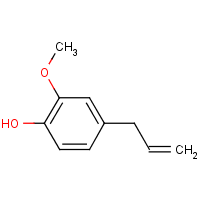Eugenol
Agent Name
Eugenol
CAS Number
97-53-0
Formula
C10-H12-O2
Major Category
Biological Agents

Synonyms
2-Methoxy-4-(2-propenyl)phenol; 1,3,4-Eugenol; 1-Hydroxy-2-methoxy-4-allylbenzene; 1-Hydroxy-2-methoxy-4-prop-2-enylbenzene; 1-Hydroxy-2-methoxy-4-propenylbenzene; 2-Methoxy-1-hydroxy-4-allylbenzene; 2-Methoxy-4-(2-propen-1-yl)phenol; 2-Methoxy-4-allylphenol; 2-Methoxy-4-prop-2-enylphenol; 2-Metoksy-4-allilofenol [Polish]; 4-Allyl-1-hydroxy-2-methoxybenzene; 4-Allyl-2-methoxyphenol; 4-Allylcatechol 2-methyl ether; 4-Allylcatechol-2-methyl ether; 4-Allylguaiacol; 4-Hydroxy-3-methoxy-1-allylbenzene; 4-Hydroxy-3-methoxyallylbenzene; 5-Allylguaiacol; Allylguaiacol; Caryophyllic acid; Eugenic acid; Eugenol (natural); FA 100; Phenol, 2-methoxy-4-(2-propenyl)-; Phenol, 4-allyl-2-methoxy-; Synthetic eugenol; p-Allylguaiacol; p-Eugenol; Phenol, 2-methoxy-4-(2-propen-1-yl)-; [ChemIDplus]
Category
Plant-Derived Allergens
Description
Colorless to pale yellow liquid with an odor of cloves; Darkened and thickened by air; [Merck Index] Colorless, light yellow, or amber liquid; [CAMEO]
Sources/Uses
A fragrance and spice derived from the oil of cloves; used in cosmetics, over-the-counter drugs, toothpastes, and foods; [Marks, p. 172-3] From numerous natural sources and the main active ingredient in cloves; Used in perfumery, flavoring, manufacture of vanillin, medicine (germicide and in over the counter drugs), dentistry (analgesic, root canal disinfectant, and in cements and other materials); Also used as an insect attractant, chemical intermediate, and denaturant for alcohol; Has been used as fungicide in pharmaceuticals and cosmetics, as antiputrescent, and to treat flatulent colic; [HSDB] Active ingredient in consumer insecticides and Japanese beetle baits/traps; [NPIRS]
Comments
A contact skin allergen present in cosmetics and foods; [Marks, p. 172] Occupational asthma confirmed in a hairdresser; [Malo] Toxic by ingestion: metabolic acidosis, proteinuria, hepatotoxicity, CNS depression, ataxia, and convulsions; [HSDB] Generally regarded as safe (GRAS) for use in foods; [FDA] A primary irritant; May cause skin sensitization and contact dermatitis; [CAMEO] Safe when used as a flavoring agent in food; Acceptable daily intake (ADI) of 0-2.5 mg/kg; [JECFA] Mildly irritating to human skin; [RTECS]
Reference Link #1
Biomedical References
Exposure Assessment
Vapor Pressure
0.01 mm Hg
Lethal Concentration
LC50 > 2,580 mg/m3/4hr
NFPA
high ambient temp required
Adverse Effects
Skin Sensitizer
Yes
Asthma
Yes
Neurotoxin
Other CNS neurotoxin
Hepatotoxin
Hepatoxic (a) from occupational exposure (secondary effect) or (b) in animal studies or in humans after ingestion
IARC Carcinogen
Not classifiable
Diseases, Processes, and Activities Linked to This Agent
Diseases
Occupational diseases associated with exposure to this agent: